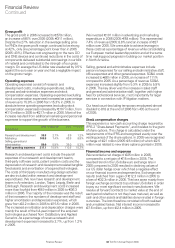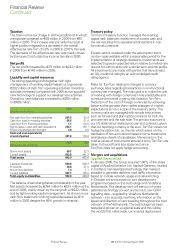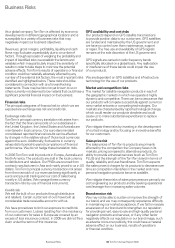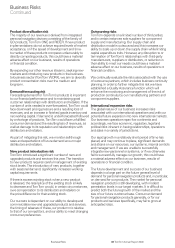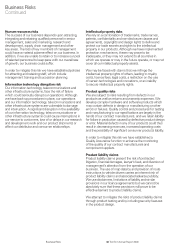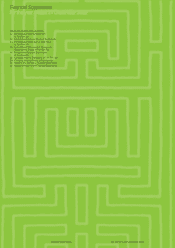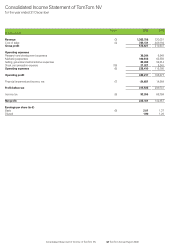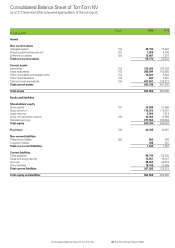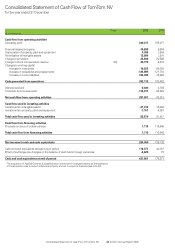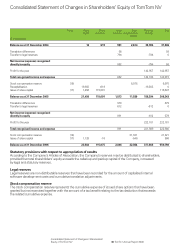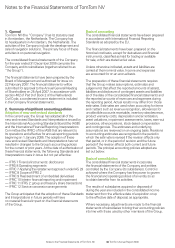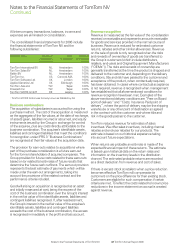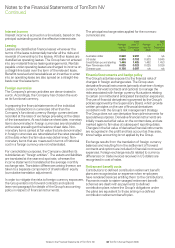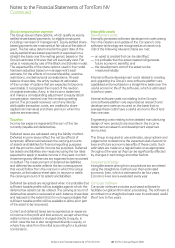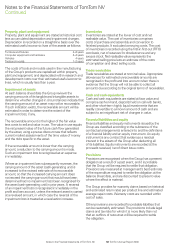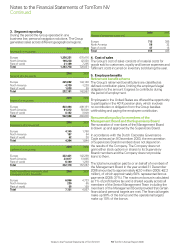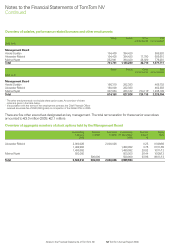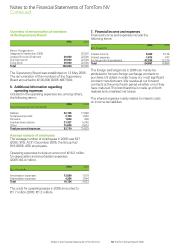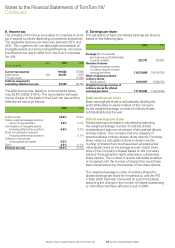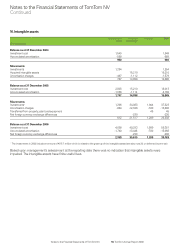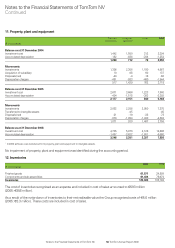TomTom 2006 Annual Report Download - page 48
Download and view the complete annual report
Please find page 48 of the 2006 TomTom annual report below. You can navigate through the pages in the report by either clicking on the pages listed below, or by using the keyword search tool below to find specific information within the annual report.46 TomTom Annual Report 2006
Notes to the Financial Statements of TomTom NV
Notes to the Financial Statements of TomTom NV
1. General
TomTom NV (the “Company”) has its statutory seat
in Amsterdam, the Netherlands. The Company has
its headquarters in Amsterdam, the Netherlands. The
activities of the Company include the development and
sale of navigation solutions. The primary focus of these
activities is on personal navigation.
The consolidated financial statements of the Company
for the year ended 31 December 2006 comprise the
Company and its subsidiaries (together referred to as
“the Group”).
The financial statements have been prepared by the
Board of Management and authorised for issue on
22 February 2007. The financial statements will be
submitted for approval to the Annual General Meeting
of Shareholders on 25 April 2007. In accordance with
section 402 of Part 9 of Book 2 of the Netherlands
Civil Code, a condensed income statement is included
in the Company financial statements.
2. Summary of significant accounting policies
Adoption of new and revised standards
In the current year, the Group has adopted all of the
new and revised Standards and Interpretations issued by
the International Accounting Standards Board (the IASB)
and the International Financial Reporting Interpretations
Committee (the IFRIC) of the IASB that are relevant to
its operations and effective for annual reporting periods
beginning on 1 January 2006. The adoption of these
new and revised Standards and Interpretations has not
resulted in changes to the Group’s accounting policies
for the current or prior years. At the date of authorisation of
these financial statements, the following Standards and
Interpretations were in issue but not yet effective:
— IFRS 7 Financial instruments: disclosures
— IFRS 8 Operating segments
— IFRIC 7 Applying the restatement approach under IAS 29
— IFRIC 8 Scope of IFRS 2
— IFRIC 9 Reassessment of embedded derivatives
— IFRIC 10 Interim financial reporting and impairment
— IFRIC 11 IFRS 2: group and treasury share transactions
— IFRIC 12 Service concession arrangements
The Group anticipates that the adoption of these Standards
and Interpretations in future periods will have
no material financial impact on the financial statements
of the Group.
Basis of accounting
The consolidated financial statements have been prepared
in accordance with International Financial Reporting
Standards as adopted by the EU.
The financial statements have been prepared on the
historical cost basis, except for derivatives and financial
instruments, classified as held for trading or available
for sale, which are stated at fair value.
Unless otherwise indicated, assets and liabilities are
carried at their nominal value. Income and expenses
are accounted for on an accrual basis.
The preparation of these financial statements requires
that the Group makes assumptions, estimates and
judgements that affect the reported amounts of assets,
liabilities and disclosure of contingent assets and liabilities
as of the date of the consolidated financial statements and
the reported amounts of revenues and expenses during
the reporting period. Actual results may differ from those
estimates. Estimates are used when accounting for items
and matters such as revenue recognition, allowances for
uncollectible accounts receivable, inventory obsolescence,
product warranty costs, depreciation and amortisation,
asset valuations, impairment assessments, taxes, earn-out
provisions, other provisions, stock-based compensation
and contingencies. The estimates and underlying
assumptions are reviewed on an ongoing basis. Revisions
to accounting estimates are recognised in the period in
which the estimate is revised if the revision affects only
that period, or in the period of revision and the future
periods if the revision affects both current and future
periods. The principal accounting policies adopted are
set out below.
Basis of consolidation
The consolidated financial statements incorporate
the financial statements of the Company and entities
controlled by the Company (its subsidiaries). Control is
achieved where the Company has the power to govern
the financial and operating policies of an entity so as
to obtain benefits from its activities.
The results of subsidiaries acquired or disposed of
during the year are included in the consolidated income
statement from the effective date of acquisition or up
to the effective date of disposal, as appropriate.
Where necessary, adjustments are made to the financial
statements of subsidiaries to bring their accounting policies
into line with those used by other members of the Group.


